 While many police departments across the country have adopted a more punitive approach to the enforcement of immigration law, some are much more welcoming towards immigrants. In new research which surveys more than 280 police departments, Linda M. Williams categorizes law enforcement agencies as “welcoming”, “neutral” and “unwelcoming”. Exploring these categories in detail, she finds that welcoming police departments are more likely to have bilingual officers, engage in outreach efforts, collaborate with non-law enforcement partners, and engage in community policing.
While many police departments across the country have adopted a more punitive approach to the enforcement of immigration law, some are much more welcoming towards immigrants. In new research which surveys more than 280 police departments, Linda M. Williams categorizes law enforcement agencies as “welcoming”, “neutral” and “unwelcoming”. Exploring these categories in detail, she finds that welcoming police departments are more likely to have bilingual officers, engage in outreach efforts, collaborate with non-law enforcement partners, and engage in community policing.
American media reports and research on law enforcement and immigrants has focused largely on local police enforcement of immigration law and the punitive actions of some departments, such as the Maricopa County Sheriffs’ Office in Arizona. This emphasis on the negative actions of some hides the full range of policies and practices towards immigrants found within police departments. Many police departments have implemented policies and practices that are intentionally designed to develop positive relationships between the police and immigrants and to encourage immigrants to call the police for assistance.
These welcoming practices are in stark contrast to punitive actions and reflect a commitment to helping immigrants and to principles of equal service to all individuals in the community. How individuals, especially those who are part of marginalized groups, are treated by administrative agencies, including police, affects how individuals view themselves and their place in society. Fair and rule-bound treatment signals that the individual is a respected and full member of society. Unfair or arbitrary treatment reinforces the individual’s perceptions of their own marginality. Police departments who adopt welcoming practices may help immigrants, who are often marginalized, feel part of their new community. In new research which measures welcoming practices among police departments, I find that welcoming police departments look quite different from unwelcoming ones; despite scarce resources, many departments have consciously and deliberately developed practices intended to develop positive relationships between the department and immigrants, encourage immigrants’ use of the agency, and help immigrants integrate into the community.
My measure of welcomeness is comprised of five dimensions and measures the extent to which a department: 1) makes its policies and processes available in the native languages of local immigrant populations, 2) reaches out to immigrant communities, 3) collaborates with other local agencies and organizations supporting or assisting immigrants, 4) provides officers training to improve interactions with immigrants, and finally, 5) enforces federal immigration laws. The five dimensions were combined into a single additive index of the degree of welcomeness of police departments: the more a department does in each of these areas, except federal immigration law enforcement, the more welcoming it is toward immigrants.
I surveyed police executives on the department’s internal practices in cities with a minimum population of 10,000 and a foreign-born population of at least 5 percent. Useable surveys were received from 284 departments for a response rate of 19 percent. Police departments that were one standard deviation or more below the mean are “unwelcoming,” and those one standard deviation or more above the mean are “welcoming.” Those between unwelcoming and welcoming are “neutral.” My analysis shows that the differences between unwelcoming and welcoming departments are remarkable.
Welcoming police departments are more likely to make written information available to non-English speakers and to offer a pay differential to attract and retain bilingual officers. Figure 1 illustrates variations in language-related practices. Welcoming and neutral departments do much more in this area than unwelcoming departments.
Figure 1 – Percent reporting to providing in-language resources
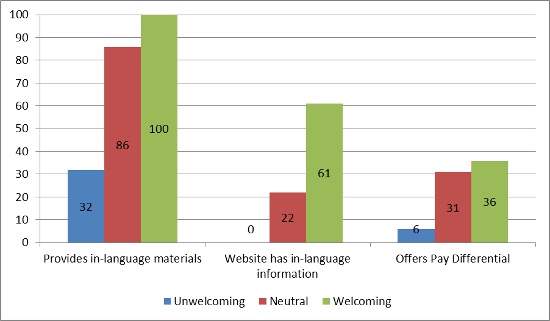
Bilingual officers are an important resource for immigrants and other officers. Figure 2 shows the differences in the percentage of certified bilingual officers. The most substantial differences are at the high and low end. A full 65 percent of unwelcoming departments have no certified bilingual officer compared to 3 percent of welcoming departments. No unwelcoming department has 21 percent or more bilingual officers while 24 percent of welcoming departments do.
Figure 2 – Percentage of certified bilingual officers
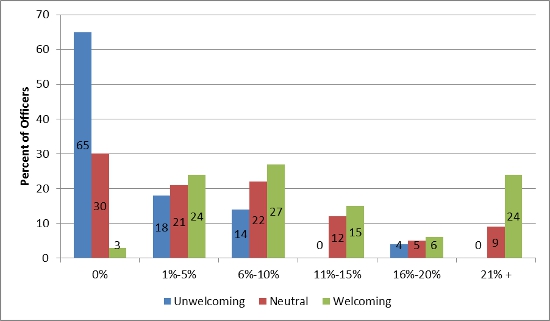
Community outreach is an important strategy for building trust and relationships and obtaining feedback and a central tenet of community policing. Many police departments reach out to immigrant communities. Figure 3 shows welcoming departments engage in more outreach efforts than unwelcoming or neutral departments. Interviews with police executives show that welcoming departments proactively look for opportunities to engage with other organizations while neutral and unwelcoming departments are more likely to wait for others to approach them.
Figure 3 – Percent participating in symbolic outreach efforts

Partnering with other community organizations can help police departments receive information and provide information to immigrants. Collaboration with other organizations grows out of a desire to help immigrants, communicate with them on services and obtain their feedback. Collaboration with other law enforcement agencies is unwelcoming because it negatively affects immigrants’ perceptions of police.
Figure 4 illustrates that welcoming departments collaborate more frequently and with more non-law enforcement partners than unwelcoming departments.
Figure 4 – Percent of collaborative activity
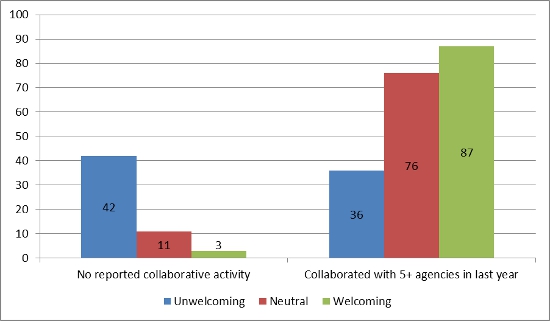
Police officers often struggle with language barriers and cultural differences, such as avoiding eye contact, during interactions with immigrants. Training, such as basic language courses or cultural training, can address these challenges. Figure 5 shows that all welcoming departments have provided some type of training compared to 29 percent of unwelcoming departments.
Figure 5 – Percent of departments that have provided training to help officers interact more effectively with immigrants
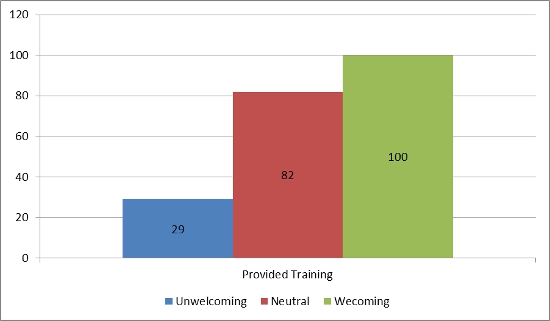
Some police departments enforce federal immigration laws or have internal policies and practices that encourage or require officers to verify the immigration status of individuals suspected of being undocumented. These policies vary considerable and are listed in Figure 6 from most unwelcoming to welcoming. Surprisingly, the vast majority of unwelcoming departments have no written policy regarding verifying immigration status. The individual officers exercise discretion, potentially resulting in inconsistency and biased policing.
Figure 6 – Immigration status enforcement policies
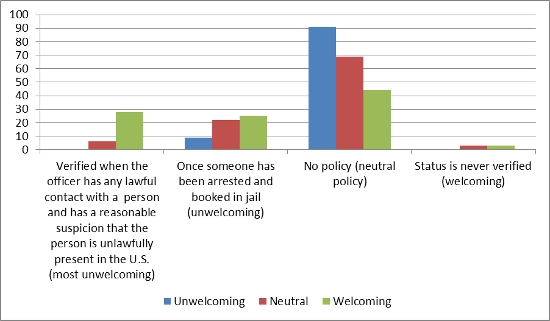
Many departments have adopted community policing to improve residents’ trust and confidence in the police. It emphasizes collaborative partnership with the community and working with the community to identify and develop solutions to problems. Three key tenets of community policing — community engagement, organizational change and a problem-solving orientation — provide a foundation for welcoming practices in police departments.
Commitment to community policing varies from superficial and symbolic to a deep commitment. Survey respondents were asked if the department engaged in ten common components of community policing within the previous twelve months. Figure 7 shows welcoming police departments are more fully engaged in community policing.
Figure 7 – Average department engagement in community policing components

The publicity about the punitive actions of some law enforcement officials may leave the impression with the general public and especially immigrants that these are standard law enforcement policies and practices. Undoubtedly, some police departments engage in this type of behavior. However, the focus on punitive actions may decrease the effectiveness of local welcoming practices since the general perception of local government agencies, especially police, is one as hostile to immigrants.
It is clear that many police departments have made intentional decisions to reach out to immigrants and departments that have adopted and are more committed to community policing are more likely to be welcoming. Welcomeness matters. It is the administrative means by which departments treat immigrants as members of the community deserving of protection and service and it may foster a dynamic whereby immigrants learn to trust and partner with the police to address issues of crime.
This article is based on the paper, Beyond Enforcement: ‘Welcomeness, Local Law Enforcement, and Immigrants’ in Public Administration Review.
Featured image credit: Robert Couse-Baker (Flickr, CC-BY-2.0)
Please read our comments policy before commenting.
Note: This article gives the views of the author, and not the position of USApp– American Politics and Policy, nor of the London School of Economics.
Shortened URL for this post: http://bit.ly/1Ie7bvP
_________________________________
 Linda M. Williams – Arizona State University, Phoenix, Arizona State University
Linda M. Williams – Arizona State University, Phoenix, Arizona State University
Linda M. Williams is an assistant professor in the School of Public Affairs at Arizona State University in Phoenix, Arizona. She studies the bureaucratic incorporation of immigrants and local government response towards immigrants. She received her Ph.D. in public administration from the University of Kansas in Lawrence, Kansas. She was a National Science Foundation IGERT fellow with the Climate Change, Humans, and Nature in the Global Environment program at KU and received a Doctoral Dissertation Research Improvement Grant from the National Science Foundation. In 2014 she received the Best Dissertation Award from the Academy of Management Public and Nonprofit Division for her work Welcoming the Outsider: Variations in Local Construction of the Law Toward Immigrants.






